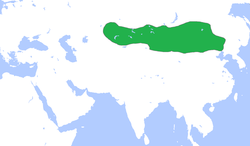Rouran
The Rouran (Chinese: 柔然; pinyin: Róurán)[3] ruled northern China during the Sixteen Kingdoms period.
Rouran Khaganate | |||||||||||||
|---|---|---|---|---|---|---|---|---|---|---|---|---|---|
| 330–555 | |||||||||||||
 Rouran Khaganate in Central Asia | |||||||||||||
| Status | Khanate | ||||||||||||
| Capital | Mumo city, Orkhon River, Mongolia | ||||||||||||
| Common languages | Ruanruan Mongolian Chinese | ||||||||||||
| Religion | Tengrism Shamanism Buddhism | ||||||||||||
| Khagan | |||||||||||||
• 330 | Yùjiǔlǘ Mùgǔlǘ | ||||||||||||
• 555 | Yujiulü Dengshuzi | ||||||||||||
| Legislature | Kurultai | ||||||||||||
| History | |||||||||||||
• Established | 330 | ||||||||||||
• Disestablished | 555 | ||||||||||||
| Area | |||||||||||||
| 405[1][2] | 2,800,000 km2 (1,100,000 sq mi) | ||||||||||||
| |||||||||||||
| Today part of | China Kazakhstan Mongolia Russia | ||||||||||||
| Rouran | |||||||||||
| Chinese | 柔然 | ||||||||||
|---|---|---|---|---|---|---|---|---|---|---|---|
| |||||||||||
| Ruru | |||||||||||
| Traditional Chinese | 蠕蠕 | ||||||||||
| Simplified Chinese | 茹茹 | ||||||||||
| |||||||||||
| Tantan | |||||||||||
| Chinese | 檀檀 | ||||||||||
| |||||||||||
They were either proto-Mongols or Turkic. They spoke the Ruanruan language, an Altaic or Sino–Tibetan language.[4]
They descended from the Xianbei. The Rouran are the first to use the words "khan" or "khagan". The Rouran Khaganate existed between the 4-6 centuries. They were then overthrown by the Gokturks. This led to the rise of the Turkic peoples.
The Rouran may have fled west after that and become part of the Pannonian Avars. The Göktürks chased after these "Avars" into the Byzantine Empire.
Origin
changeThe Rouran were nomads. They lived in the eastern Eurasian Steppe (Mongolia and northeast China). They overthrew the Xianbei. Most Xianbei moved south and lived in Northern China.[5] Kwok Kin Poon argues the Rouran descended from the Donghu Xianbei.[6]
History
changeThe founder of the Rouran Khaganate was Yujiulu Shelun. He descended from slaves of the Xianbei. The Xianbei used the word rouran to mean "wriggling worms".
After the Xianbei moved south in the 3rd century, the Rouran took over and conquered a lot of land.
In 402 Shelun unified all of the Rouran. They defeated the neighboring Tiele and expanded to the Silk Roads. They then conquered and vassalized the Hephthalites (of Central Asia) until 5th century.[7][8]
The Hepthalites then moved towards India and replaced the Yuezhi in Bactria. The Hephtalites borrowed much culture and language from the Rouran: including the word "Khan".[8]
In 429, Northern Wei (where the Xianbei settled) attacked the Rouran and killed many.[7]
In 434, the Rouran made a heqin with Northern Wei.[9]
Between 440-460, the Northern Wei attacked and defeated the Rouran several times.[7][9][7]
The Rouran made a heqin with the Han-Chinese ruler Gao Huan of Eastern Wei.[10]
In 508, the Tiele defeated the Rouran.
In 516, the Rouran defeated the Tiele.
Overthrow by Gokturks
changeIn 551, Bumin of the Ashina Göktürks (Chinese: 突厥) defeated the Tiele revolt for the Rouran. In return Bumin asked for a Rouran princess (heqin). Rouran refused, so Bumin declared independence.[11]
Bumin made a heqin with the Western Wei (descend from Northern Wei). Bumin then attacked the Rouran in 552, killing Yujiulü Anagui. Bumin then conquered Otuken.
He declared himself Illig Khagan and started the Turkic Khaganate. He died soon Bumin but his son Issik Qaghan succeeded him. Issik continued attacking the Rouran but died a year later in 553. His brother Muqan Qaghan finished the job and annihilated the Rouran in 555.[11][9]
References
change- ↑ Taagepera, Rein (1979). "Size and Duration of Empires: Growth-Decline Curves, 600 B.C. to 600 A.D.". Social Science History. 3 (3/4): 129. doi:10.2307/1170959. JSTOR 170959.
- ↑ Turchin, Peter; Adams, Jonathan M.; Hall, Thomas D (December 2006). "East-West Orientation of Historical Empires". Journal of World-systems Research. 12 (2): 222. ISSN 1076-156X. Retrieved 16 September 2016.
- ↑ Zhang, Min. "On the Defensive System of Great Wall Military Town of Northern Wei Dynasty" China's Borderland History and Geography Studies, Jun. 2003 Vol. 13 No. 2. Page 15.
- ↑ West, Barbara A. (2008). Encyclopedia of the Peoples of Asia and Oceania. Infobase Publishing. p. 687. ISBN 978-0-8160-7109-8. Retrieved 26 May 2011.
- ↑ Hyacinth (Bichurin), Collection of information on peoples lived in Central Asia in ancient times, 1950. p.209
- ↑ "The Northern Wei state and the Juan-juan nomadic tribe". The University of Hong Kong Scholar hub. Retrieved 2015-11-16.
- ↑ 7.0 7.1 7.2 7.3 Grousset (1970), p. 67.
- ↑ 8.0 8.1 Kurbanov, A. The Hephthalites: Archaeological and historical analysis. PhD dissertation, Free University, Berlin, 2010
- ↑ 9.0 9.1 9.2 Xiong 2009.
- ↑ Lee, Lily Xiao Hong; Stefanowska, A. D. (2007). Biographical Dictionary of Chinese Women: Antiquity Through Sui, 1600 B.C.E.-618 C.E. M.E. Sharpe. ISBN 978-0-7656-4182-3. p. 316.
- ↑ 11.0 11.1 Barfield 1989.